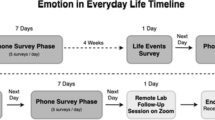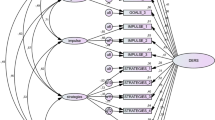Abstract
This research used data from a study on daily emotional experience in adulthood to examine the associations between age, emotion complexity, and emotion regulation. Data were drawn from a study of daily stress that included 239 participants ranging in age from 18 to 89 from North Central Florida. Two indicators of emotion complexity were considered: emotion differentiation and the co-occurrence of positive and negative affect. Emotion regulation was assessed in terms of individuals’ likelihood of maintaining adaptive emotion states. There were no age differences in adults’ co-occurrence of positive and negative emotions. In contrast to theories suggesting age would be associated with greater emotion complexity, the findings revealed that older adults had lower differentiation scores than younger adults. Age was also associated with more adaptive patterns of emotion regulation. Specifically, older adults persisted in low negative states and moved out of high negative states more readily than younger adults. Finally, neuroticism, self-concept incoherence, mean daily stress, and emotion complexity were associated with emotion regulation. Notably, adults who reported a greater mix of positive and negative affect moved out of high negative affect states more rapidly than adults with lower co-occurrence scores. This finding is in keeping with a growing body of work suggesting that positive affect promotes recovery from negative affect. Overall, the findings suggest that although emotion complexity is associated with emotion regulation, it does not appear to be a key factor underlying age differences in emotion regulation.


Similar content being viewed by others
Notes
It is important to note that such discrepancies do not appear to be the result of different methodologies. For instance Carstensen et al., (2000) and Grühn et al. (2011) both employed experience sampling protocols, yet their findings differ. Rather, Grühn et al.’s findings concur with those from Ong and Bergeman’s (2004) daily diary study, whereas Carstensen et al’s findings concur with the findings from Magai et al.’s (2006) emotion induction task.
Based on the recommendations of a reviewer, we also examined whether computing the emotion differentiation scores via principal axis factor analysis, using the squared multiple correlations of the items as the starting value for the commonalities, would yield similar or different results. The two methods of computing the emotion differentiation scores were highly associated (r = 0.71, p < 0.001) and the overall findings were unchanged. Given this outcome and to permit the direct comparison of our findings with findings from previous studies, we decided to report the results based on the principal components approach.
There is debate with respect to whether short-term fluctuations reflect true change as opposed to measurement error (cf., Eizenman et al. 1997). Research on daily emotions often treats any fluctuation as evidence of short-term change (see work on stress and daily emotions; e.g., Almeida et al. 2005; Bolger et al. 1989). To consider the possibility that small fluctuations could simply be measurement error, we re-estimated the conditional probabilities with the criterion that a person’s daily score needed to be at least half a within-person standard deviation above his or her mean to be categorized as being “above the mean” for that day. None of the findings changed when the conditional probabilities were adjusted in this manner.
Block (1961) introduced his index as an indicator of self-concept differentiation (SCD). Given the accumulating empirical evidence that the SCD index is indicative of a fragmented and incoherent self-concept rather than a specialized self-concept, we prefer to use the term “self-concept incoherence” rather than the term “self-concept differentiation.”
References
Almeida DM, Wethington E, Kessler RC (2002) The Daily Inventory of Stressful Experiences (DISE): an interview-based approach for measuring daily stressors. Assessment 9:41–55
Almeida DM, Neupert SD, Banks DR, Serido J (2005) Do daily stress processes account for socioeconomic health disparities? J Gerontol Ser B Psychol Sci (Special Issue II) 60B:34–39
Anstey KJ, Luszcz MA, Hofer SM (2003) Cross-sectional and longitudinal patterns of dedifferentiation in late-life cognitive and sensory function: the effects of age, ability, attrition, and occasion of measurement. J Exp Psychol Gen 132:470–487. doi:10.1037/0096-3445.132.3.470
Aspinwall LG, Taylor SE (1997) A stitch in time: self-regulation and proactive coping. Psychol Bull 121:417–436. doi:10.1037/0033-2909.121.3.417
Baron RM, Kenny DA (1986) The moderator-mediator variable distinction in socialpsychological research: conceptual, strategic, and statistical considerations. J Pers Soc Psychol 51:1173–1182. doi:10.1037/0022-3514.51.6.1173
Birditt KS, Fingerman KL, Almeida DM (2005) Age differences in exposure and reactions to interpersonal tensions: a daily diary study. Psychol Aging 20:330–340. doi:10.1037/0882-7974.20.2.330
Blanchard-Fields F, Mienaltowski A, Seay RB (2007) Age differences in everyday problem-solving effectiveness: older adults select more effective strategies for interpersonal problems. J Gerontol Ser B Psychol Sci 62B:61–64
Block J (1961) Ego-identity, role variability, and adjustment. J Consult Psychol 25:392–397
Bolger N, Schilling E (1991) Personality and the problems of everyday life: the role of neuroticism in exposure and reactivity to daily stressors. J Pers 59:355–386. doi:10.1111/j.1467-6494.1991.tb00253.x
Bolger N, DeLongis A, Kessler RC, Schilling EA (1989) Effects of daily stress on negative mood. J Pers Soc Psychol 57:808–818. doi:10.1037/0022-3514.57.5.808
Carstensen LL, Mikels JA (2005) At the intersection of emotion and cognition: the positivity effect. Curr Dir Psychol Sci 14:117–121. doi:10.1111/j.0963-7214.2005.00348.x
Carstensen LL, Isaacowitz DM, Charles ST (1999) Taking time seriously: a theory of socioemotional selectivity. Am Psychol 54:165–181. doi:10.1037/0003-066X.54.3.165
Carstensen LL, Pasupathi M, Mayr U, Nesselroade JR (2000) Emotional experience in everyday life across the life span. J Pers Soc Psychol 79:644–655. doi:10.1037/0022-3514.79.4.644
Carver CS, Antoni MH (2004) Finding benefit in breast cancer during the year after diagnosis predicts better adjustment 5 to 8 years after diagnosis. Health Psychol 23:595–598. doi:10.1037/0278-6133.23.6.595
Chipperfield JG, Perry RP, Weiner G (2003) Discrete emotions in later life. J Gerontol Ser B Psychol Sci Soc Sci 58:23–34
Costa PT, McCrae RR (1992) Professional manual. Revised NEO Personality Inventory (NEO PI-R) and NEO Five-Factor Inventory (NEO-FFI). Psychological Assessment Resources, Inc, Odessa, FL
Diamond LM, Aspinwall LG (2003) Emotion regulation across the life span: an integrative perspective emphasizing self-regulation, positive affect, and dyadic processes. Motiv Emot 27:125–156
Diehl M, Hay EL (2007) Contextualized self-representations in adulthood. J Pers 75:1255–1284. doi:10.1111/j.1467-6494.2007.00475.x
Diehl M, Hay EL (2010) Risk and resilience factors in coping with daily stress in adulthood: the role of age, self-concept incoherence, and personal control. Dev Psychol 46:1132–1146. doi:10.1037/a0019937
Diehl M, Hastings CT, Stanton JM (2001) Self-concept differentiation across the adult life span. Psychol Aging 16:643–654. doi:10.1037/0882-7974.16.4.643
Donahue EM, Robins RW, Roberts BW, John OP (1993) The divided self: concurrent and longitudinal effects of psychological adjustment and social roles on self-concept differentiation. J Pers Soc Psychol 64:834–846. doi:10.1037/0022-3514.64.5.834
Eid M, Larsen RJ (eds) (2008) The science of subjective well-being. Guilford Press, New York
Eizenman DR, Nesselroade JR, Featherman DL, Rowe JW (1997) Intraindividual variability in perceived control in an older sample: the MacArthur Successful Aging Studies. Psychol Aging 12:489–502. doi:10.1037/0882-7974.12.3.489
Feldman Barrett L (2004) Feelings or words? Understanding the content in self-report ratings of experienced emotion. J Pers Soc Psychol 87:266–281. doi:10.1037/0022-3514.87.2.266
Ghisletta P, Lindenberger U (2003) Age-based structural dynamics between perceptual speed and knowledge in the Berlin Aging Study: direct evidence for ability dedifferentiation in old age. Psychol Aging 18:696–713. doi:10.1037/0882-7974.18.4.696
Gross J (1998) The emerging field of emotion regulation: an integrative review. Rev Gen Psychol 2:271–299. doi:10.1037/1089-2680.2.3.271
Gross JJ (2001) Emotion regulation in adulthood: timing is everything. Curr Dir Psychol Sci 10:214–219. doi:10.1111/1467-8721.00152
Gross JJ, Carstensen LL, Pasupathi M, Tsai J, Skorpen CG, Hsu AYC (1997) Emotion and aging: experience, expression, and control. Psychol Aging 12:590–599. doi:10.1037/0882-7974.12.4.590
Grühn D, Rebucal K, Diehl M, Lumley M, Labouvie-Vief G (2011). Time-based indicators of emotional complexity: is it good to be complex? Manuscript submitted for publication
Hay EL, Diehl M (2010) Reactivity to daily stressors in adulthood: the importance of stressor type in characterizing risk factors. Psychol Aging 25:118–131. doi:10.1037/a0018747
Labouvie-Vief G (2003) Dynamic integration: affect, cognition, and the self in adulthood. Curr Dir Psychol Sci 12:201–206. doi:10.1046/j.0963-7214.2003.01262.x
Labouvie-Vief G, Medler M (2002) Affect optimization and affect complexity: modes and styles of regulation in adulthood. Psychol Aging 17:571–588. doi:10.1037/0882-7974.17.4.571
Labouvie-Vief G, Diehl M, Jain E, Zhang F (2007) Six-year change in affect optimization and affect complexity across the adult life span: a further examination. Psychol Aging 22:738–751. doi:10.1037/0882-7974.22.4.738
Larsen RJ, Cutler SE (1996) The complexity of individual emotional lives: a within-subject analysis of affect structure. J Soc Clin Psychol 15:206–230
Larsen RJ, Prizmic Z (2008) Regulation of emotional well-being: overcoming the hedonic treadmill. In: Eid M, Larsen RJ (eds) The science of subjective well-being. Guilford Press, New York, pp 258–289
Lazarus RS (1990) Theory based stress measurement. Psychol Inq 1:3–13. doi:10.1207/s15327965pli0101_1
Magai C, Consedine NS, Krivoshekova YS, Kudadjie-Gyamfi E, McPherson R (2006) Emotion experience and expression across the adult life span: insights from a multimodal assessment study. Psychol Aging 21:303–317. doi:10.1037/0882-7974.21.2.303
Mroczek DK, Almeida DM (2004) The effect of daily stress, personality, and age on daily negative affect. J Pers 72:355–378. doi:10.1111/j.0022-3506.2004.00265.x
Ochsner KN, Gross JJ (2005) The cognitive control of emotion. Trends Cogn Sci 9:242–249. doi:10.1016/j.tics.2005.03.010
Ong AD, Bergeman CS (2004) The complexity of emotions in later life. J Gerontol Ser B Psychol Sci 59B:117–122
Preacher K, Hayes AF (2004) SPSS and SAS procedures for estimating indirect effects in simple mediation models. Behav Res Methods Instrum Comput 36:717–731. doi:10.3758/BF03206553
Radloff LS (1977) The CES-D scale: a self-report depression scale for research in the general population. Appl Psychol Meas 1:385–401. doi:10.1177/014662167700100306
Rafaeli-Mor E, Steinberg J (2002) Self-complexity and well-being: a review and research synthesis. Pers Soc Psychol Rev 6:31–58. doi:10.1207/S15327957PSPR0601_2
Ready RE, Carvalho JO, Weinberger MI (2008) Emotional complexity in younger, midlife, and older adults. Psychol Aging 23:928–933. doi:10.1037/a0014003
Scheibe S, Carstensen LL (2010) Emotional aging: recent findings and future trends. J Gerontol Ser B Psychol Sci 65B:135–144. doi:10.1093/geronb/gbp132
Sheldon KM, Ryan RM, Rawsthorne LJ, Ilardi B (1997) Trait self and true self: cross-role variation in the big-five personality traits and its relations with psychological authenticity and subjective well-being. J Pers Soc Psychol 73:1380–1393. doi:10.1037/0022-3514.73.6.1380
Sliwinski M (2008) Measurement-burst designs for social health research. Soc Pers Psychol Compass 2:245–261. doi:10.1111/j.1751-9004.2007.00043.x
Stawski RS, Sliwinski MJ, Almeida DM, Smyth JM (2008) Reported exposure and emotional reactivity to daily stressors: the roles of adult age and global perceived stress. Psychol Aging 23:52–61. doi:10.1037/0882-7974.23.1.52
Tugade MM, Fredrickson BL (2004) Resilient individuals use positive emotions to bounce back from negative emotional experiences. J Pers Soc Psychol 86:320–333. doi:10.1037/0022-3514.86.2.320
van Eck M, Nicolson NA, Berkhof J (1998) Effects of stressful daily events on mood states: relationship to global perceived stress. J Pers Soc Psychol 75:1572–1585. doi:10.1037/0022-3514.75.6.1572
Watson D, Clark LA, Tellegen A (1988) Development and validation of brief measures of positive and negative affect: the PANAS scales. J Pers Soc Psychol 54:1063–1070. doi:10.1037/0022-3514.54.6.1063
Zautra AJ, Potter PT, Reich JW (1997) The independence of affects is context-dependent: an integrative model of the relationship between positive and negative affect. In: Schaie KW, Lawton MP (eds) Annual review of gerontology and geriatrics. Vol. 17: focus on emotion and adult development. Springer Publishing, New York, pp 75–103
Zautra AJ, Berkhof J, Nicolson NA (2002) Changes in affect interrelations as a function of stressful events. Cogn Emot 16:309–318. doi:10.1080/02699930143000257
Zelenski JM, Larsen RJ (2000) The distribution of basic emotions in everyday life: a state and trait perspective from experience sampling data. J Res Pers 34:178–197. doi:10.1006/jrpe.1999.2275
Zevon MA, Tellegen A (1982) The structure of mood change: an idiographic/nomothetic analysis. J Pers Soc Psychol 43:111–122. doi:10.1037/0022-3514.43.1.111
Acknowledgments
The research presented in this article was supported by grant R01 AG21147 from the National Institute on Aging, National Institutes of Health.
Author information
Authors and Affiliations
Corresponding authors
Additional information
Responsible editor: D.J.H. Deeg
Rights and permissions
About this article
Cite this article
Hay, E.L., Diehl, M. Emotion complexity and emotion regulation across adulthood. Eur J Ageing 8, 157–168 (2011). https://doi.org/10.1007/s10433-011-0191-7
Published:
Issue Date:
DOI: https://doi.org/10.1007/s10433-011-0191-7




